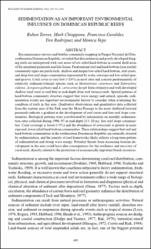Mostrar el registro sencillo del ítem
Sedimentation as an important environmental influence on Dominican Republic reefs
| Autor | Torres, Rubén E. | |
| Autor | Chiappone, Mark | |
| Autor | Geraldes, Francisco | |
| Autor | Rodríguez, Yira | |
| Autor | Vega, Mónica | |
| Fecha de admisión | 2024-02-13T22:49:17Z | |
| Fecha disponible | 2024-02-13T22:49:17Z | |
| Año | 2001 | |
| Citación | Torres, R., Chiappone, M., Geraldes, F., Rodriguez, Y., & Vega, M. (2001). Sedimentation as an important environmental influence on Dominican Republic reefs. Bulletin of Marine Science, 69(2), 805-818. Recuperado de: | es |
| URI | https://bvearmb.do/handle/123456789/4080 | |
| Sinopsis | Reconnaissance surveys and benthic community mapping in Parque Nacional del Este, southeastern Dominican Republic, revealed that discontinuous and poorly developed fringing reefs are interspersed with vast areas of low-relief hard-bottom in coastal shelf areas of the mainland peninsula and Isla Saona. Predominant reef and hard-bottom (non-reefal) community types are patch reefs, shallow and deeper low-relief hard-bottom, reef crests, and deep fore reef slope communities represented by rocky outcrops and low-relief spurand-groove. Coral cover is very low (<10%) in most sites and consists predominately of relatively sediment-tolerant species such as Montastraea cavernosa and Siderastrea siderea. Acropora palmata and A. cervicornis do not form extensive and well-developed shallow (reef crest or reef flat) or mid-depth (fore reef terrace) reefs. Spatial patterns of hard-bottom community structure suggest that wave energy and natural, episodic sedimentation events are important environmental factors to consider when evaluating the condition of reefs in this area. Qualitative observations and quantitative data collected from the eastern area of the Park near the Mona Passage to the more sheltered leeward peninsula indicate a gradient in the development of reef crests and fore reef slope communities. Biological patterns were corroborated by information on monthly sedimentation rates collected during 1996–97 in mid-depth (15–20 m), fore reef slope communities. Coral coverage is lower (<5%) and the abundance of octocorals is greater in more exposed, lower relief hard-bottom communities. These relationships suggest that reef and hard-bottom communities in the southeastern Dominican Republic are naturally stressed by sedimentation, and the paucity of reef frameworks likely reflects a long-term pattern of sedimentation and strong wave energy. Potential threats from increasing tourism development in the area could have dire consequences for the resilience and recovery of coral reefs, directly related to the protection of economically important beach resources. | es |
| Idioma | English | es |
| Publicado | Bulletin of Marine Science, 69(2), 805-818 | es |
| Derechos | Available at: https://www.ingentaconnect.com/ | es |
| Materia | Biodiversidad - República Dominicana | es |
| Materia | Recursos costeros y marinos | es |
| Materia | Arrecifes de coral | es |
| Título | Sedimentation as an important environmental influence on Dominican Republic reefs | es |
| Tipo de material | Article | es |
| Tipo de contenido | Scientific research | es |
| Acceso | Open | es |
| Audiencia | Technicians, professionals and scientists | es |
Ficheros en el ítem
Este ítem aparece en la(s) siguiente(s) colección(es)
-
Investigación ambiental [1745]


